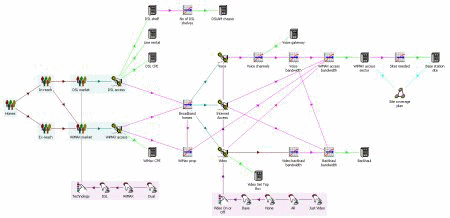 The STEM visual software for the reliable modelling of business featured prominently in a two-week
training event, which took place 16–27 July 2006 at the National Telecommunications
Institute in Cairo, and was organised by the Telecommunication Development Bureau
of the International Telecommunication Union (ITU-BDT).
The STEM visual software for the reliable modelling of business featured prominently in a two-week
training event, which took place 16–27 July 2006 at the National Telecommunications
Institute in Cairo, and was organised by the Telecommunication Development Bureau
of the International Telecommunication Union (ITU-BDT).
As the first event of its kind, the ambitious
Regional Network Planning Workshop
with Tool Case Studies for the Arab Region
provided a broad introduction
to the principles and preferred methodologies for telecoms business and network
planning, combined with hands-on experience with leading commercial tools provided
by ITU partners.
Ambition for excellence in business and network planning
Network architectures are changing to meet the requirements of new services and
applications. Next-generation equipment (such as soft switches or session controllers)
and a new call/data traffic mix will be introduced. Different solutions may be considered
for a smooth transition from existing network infrastructures, and the merits of
each must be assessed using a portfolio of the powerful and modern tools available
on the market today which can take proper account of the market, technical and regulatory
environment. Furthermore, as the range of available technologies continues to grow,
so increases the importance of careful planning and the analysis of alternatives
in order to assure the required network capacities and associated quality of service,
and understand the required investment.
The Cairo workshop was arranged for network planners and managers from telecoms
operators, policy makers and regulators of developing countries and countries with
economies in transition in the Middle East and North Africa (MENA) region. Through
a number of case studies, the principles and preferred methodologies for telecoms
business and network planning were introduced, followed by several days’ training
on each of the network and business-planning software tools provided by established
partners of the ITU.
Intensive programme of presentations and hands-on training
|
Day
|
Topic
|
|
1
|
ITU-BDT activities on business and network planning
Role of planning in the current network architecture scenario
|
|
2
|
Introduction to supporting business and network-planning tools
|
|
3–4
|
STEM visual software for the reliable modelling of business
|
|
5–6
|
Planning tools for radio networks (LS Telcom/Spectrocan)
|
|
7–8
|
Planning tools for fixed networks (VPIsystems)
|
|
9–10
|
More detailed case studies on tools of participants’ choice
|
Simplified event programme
The event was attended by approximately 40 delegates from countries throughout the
Arab region, including Algeria, Djibouti, Egypt, Jordan, Kuwait, Libya, Mauritania,
Oman, Palestine, Saudi Arabia, Sudan, Syria, Tunisia, UAE and Yemen. Some of the
training sessions were run in two parallel tracks to keep the class sizes manageable.
A brand new series of STEM modelling exercises was created for the event, framed
around a simplified business-case comparison of WiMAX and DSL for the provision
of broadband service in rural areas. In anticipation of the participants’ widely
varying knowledge and skills, the exercises used an existing model with immediate
results as a vehicle for learning basic telecoms business-planning concepts, as
well as a platform for adding various model refinements in later exercises. Both
STEM courses were run back-to-back by Robin Bailey, with support and helpful industry
insight from ITU expert, Mr Oscar Gonzalez Soto.

Structure of STEM business-case comparison of WiMAX and DSL for rural areas
This WiMAX-DSL model was first presented at the earlier ITU-BDT
Regional Seminar
on Mobile and Fixed Wireless Access for Broadband Applications for the Arab Region
,
19–22 June 2006. The new exercises were very well received by the Cairo delegates
and will be offered to all STEM customers, from the next
open training session
, 14–19 September, immediately before the STEM User
Group Meeting, 20–21 September in Cambridge, UK.
Future co-operation
The ITU-BDT is developing partnerships
with the vendors of professional network planning tools to support its missions
promoting best-practice planning techniques in developing countries. Together with
ITU-BDT, we have negotiated a co-operative agreement that will add the STEM visual software for reliable modelling of business to a roster of network planning tools to be used for training
purposes and to be presented during official ITU-BDT workshops, seminars and training
courses.
Through specific cooperative agreements, ITU experts plan to model high-level business
cases for 3G mobile and next-generation networks (NGN) to help the governments and
newly-formed regulators of developing nations assess the market potential of their
nascent telecoms sectors. It is also expected that some of these organisations,
and operators in the same territories, will want to develop such activities working
directly with the tool vendors, who all provide vital consultancy services to ensure
that these sophisticated tools are properly applied and will help their users make
the correct strategic choices for their future network businesses.
The National Telecommunications Institute (NTI)
has taken the lead in training Egyptian engineers on the planning, deployment and
maintenance of a modernised telecommunications infrastructure for Egypt and will
help implement the objectives and components of Egypt’s Information Society Initiative.
NTI empowers the Egyptian ICT industry through the transfer of know-how from leading
technology providers to its professional training programs and supports concurrent
development in the Arab and African regions as a regional Centre of Excellence for
consultation and training in ICT.
The three sectors of the
International
Telecommunication Union
– Radiocommunication (ITU-R), Telecommunication
Standardization (ITU-T), and Telecommunication Development (ITU-D) – work today
to build and shape tomorrow’s networks and services: setting standards that facilitate
seamless interworking of equipment and systems, adopting operational procedures
for wireless services, and designing programmes to improve telecommunication infrastructure
in the developing world.